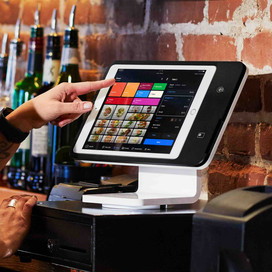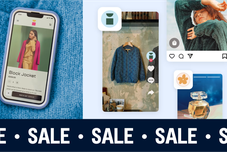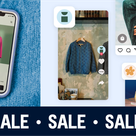Table of contents
Thousands of food and beverage industry professionals trek to Chicago each spring for four days of learning, networking, and sampling at the National Restaurant Association Show. This year organizers went big. The crowd topped 58,000 attendees — a 6% spike in total attendance, including 22% more international participants, compared to 2023.
“Going bigger” is a concept that many restaurant owners are making their own. Ninety percent of surveyed restaurant leaders said that they plan to expand their businesses and start new revenue streams beyond core offerings this year, according to the 2024 Square Future of Restaurants report.
Square put a spotlight on Broad Street Oyster Co. Founder Christopher Tompkins and Square Head of Food and Beverage and Restaurateur Ming-Tai Huh as they took the stage with CNBC’s Amelia Lucas. Both shared how they’ve grown and evolved their restaurant businesses with help from their restaurant technology.
Note: The following transcript from their panel discussion has been edited for format and clarity.
Lucas: Opening a new restaurant can take months or even years. There’s a lot of uncertainty in that. How are you balancing that against this added economic pressure? Is there a stronger need to bring the customer back that we didn’t really face in 2018 or 2019?
Huh: For my projects, including one I started during the pandemic, that was three years in the making. Construction, licensing, you name it — regulations. Ultimately, you’re kind of at the whim of what’s happening. If you opened your doors on time, I’d love to talk to you. I don’t know how you did that.
Pretty much you just have to roll with it and hope that you hit the right groove — ideally now spring for a restaurant in New England. We want to hit summer as quickly as possible, with outdoor seating and everything. But you have to go with the flow in understanding that, “Okay, we have a great product. We’ve done some testing and measurement out of our other kitchens,” and ultimately get the excitement from a marketing perspective.
Tompkins: We’ve tried to be very strategic with the last three openings. We’ve tried to target iconic, tourist-heavy locations so that we can develop a baseline foot traffic that would be able to sustain the restaurant. We opened at Ghirardelli Square, at the end of the Huntington Beach Pier, and within Grand Central Market. All three of those locations are pretty busy almost every single day. That helps us get to the baseline so that we’re not so dependent on consumer trends and seasonality.
Lucas: Besides focusing on tourist locations, are there other ways you decided, ‘Oh, this is a great spot for us to open a location?’
Tompkins: For me personally, it was based upon the deal. That really swayed me for our first restaurant. To be honest, I didn’t want to open in Malibu. I thought it was too small of a town. I didn’t know enough about the market. I thought it was a death sentence. After really looking at the deal that was presented, I thought, “Well what do I have to lose?” At the time it was nothing, so that allowed me to think that through.
Huh: For us, geographic density is our friend. My restaurants are within two square miles within Cambridge, Massachusetts. We like that because we can share employees much more effectively and plan the supply chain route more effectively. Granted, they’re different concepts, different menus, and different styles of service, but we like geographic density. For our project that’s opening in July in Cambridge, it’s really exciting because it’s a part of the city’s redevelopment. So we have this deep connection with the neighborhood and community. We really weren’t looking for the project; it came to us.
Lucas: There’s a lot of restaurant tech that’s available. Can you name at least one tool that you feel has been instrumental in your success?
Tompkins: For me the first one was the Square Reader, which during my early pop-up phase was revolutionary. I was like, “Oh, wow, I can take credit card payment on the street corner. This is perfect.” Then as I opened my first restaurant and learned very quickly that we didn’t know what we were doing — and customers were very quick to tell us that we didn’t know what we were doing — I said, “Oh, well, we should probably figure out the operations side.”
So number two for me would be the [Square] Kitchen Display System. That was just another moment where I felt like a dummy for not knowing that that type of product existed. And then once we turned it on and started to roll it out in our kitchen, it just changed everything for us.
Huh: When it comes to manager log, web-based sales, reporting — those are really the tools that allow me to get the most out of running the business. I’m telling you sometimes I’m up late, but I’m reading that manager log at 2:00 a.m., finding out what happened, what’s going on, so we can prepare best for the next day. So communication tools back and forth with the staff and the stores and cross referencing with sales is really the best tool.
Lucas: As you expand, how does technology help you get more out of your restaurants, and vice versa? How does that scale that you’re achieving now, even if it’s on a smaller level, really help you?
Tompkins: It’s really just some of the points that Ming brought up — communication. For me it’s also being able to track the Dashboard in Square, like, “Okay, times of day. Where do we need more people? When can we pull back on that schedule? When are we the busiest? When can we adjust our hours?” We adjusted the hours of our location in Malibu two or three times over the last five years as we’ve gotten busier and busier, and it’s allowed for us to really capture what I think is the best amount of customers from the hours of 11 a.m. to 9 p.m.
Huh: Yeah, absolutely. I’ll echo that same thing. We’ve got about 150 employees. With this new location opening up, it’ll be closer to 200. Managing staff is really, really important, whether it’s scheduling — obviously payroll. All of the things that Square offers really allow you to do everything, from top to bottom. The tools that are helping me manage the staff are really important for me as the operator. A lot of people are counting on me to pay their rent or mortgage, so that’s what’s important to me. If you have happy employees, you’re likely to have happy guests.
Lucas: It wouldn’t be a restaurant technology panel if we didn’t talk about artificial intelligence. The biggest buzzword in the industry right now. Do either of you use AI within restaurant operations? In what ways have you seen it in your business help make things easier?
Tompkins: I think that AI has been tacked on to a lot of things lately. Literally, if you walk the floor, there’s an AI dishwasher. I saw it yesterday. I’ve been using it mostly with 7shifts — part of their predictive scheduling platform. I also used ChatGPT to help organize my thoughts for today’s panel. I think that’s going to be a bigger and bigger influence. Besides that, I don’t really know that technology is being implemented into things that I may be using every single day. I’m sure it is.
Huh: For us AI and automation is really behind the scenes. It’s not really guest-facing as much for my restaurant group. We use it for our back office, managing invoices, line items — anything in the back office that ultimately helps us understand our costs, our COGs, our spending, our purchasing. That’s where I think we are putting a lot of attention to it, because that means profit, understanding whether we’re making it or not. As far as front of house, I’m highly encouraging the marketing teams and our events catering to use AI to help them go faster, reach out to more guests, more customers, more repeat clients for what we have to offer. It’s a tool that I’m giving them and saying, “Hey, use it. It’s available. We have it. It’s part of our platform.”
Live Audience Q&A
Can you speak more about the ways you use the data that Square offers to make difficult decisions or decisions that perhaps you wouldn’t have felt less confident in making in the past?
Tompkins: A couple years ago, our signature item was a lobster roll. Lobster pricing was through the roof. It was two times what we were typically used to. After looking at the cost and then looking at the sales to see how many lobster rolls we sold, it made it a lot easier to recognize, “Maybe I should raise it $2.” That number was really difficult to just walk away from, knowing that the cost was going up and seeing that just tacking on a dollar or two, at that point, would bring in an additional few hundred thousand dollars in revenue. It’s, I guess, keeping your ego in check.
Huh: We price a lot of prix fixe events with Square Online. Whether tickets are 85-plus periods or not, we are really trying to understand that elasticity. Sometimes we go out and say, “We’ve only got 30 tickets sold out of 100. We’re a week and a half until this event. How do we ultimately lower that price without alienating those people who previously bought those tickets?” The thing is, with the technology, you can reach out to people and say, “Hey, we’re going to take care of you, move a little faster. Here’s an early bird discount.”
How often do you look to balance growth between in-restaurant and online?
Tompkins: Almost 99% of our transactions are in-store. We didn’t even offer delivery service until 20 months ago, and even 20 months later it’s still around 1%–2% at some of our locations. If you’re sitting a few steps away from the beach on PCH eating a lobster roll, that’s a different experience than if you’re getting it delivered to downtown LA. You can have it both ways, of course, but it’s not the same. I think that one of the things that we really focused on was the online preorder, which at one point was probably 15% of our Malibu store’s transactions. That was a need that we needed to fill, because we were so busy we had a line that was an hour and a half or two hours long. It got to a point where customers didn’t want to wait in line, so we thought to ourselves, “How can we make it better for them?” That’s when we built the Square Online preorder. We did that for, I think it was a year or two, and then rolled the dice on delivery. If anything, when we took that step in delivery, it just kind of proved the thought that I had, which was, “I don’t think that this necessarily travels well. I don’t think that we have to go out of our way to really focus on third-party delivery and just really focus on what’s happening in our store and online.”
Are you using any loyalty programs to bring customers back? Any technology you’re using to incentivize customers?
Tompkins: We just started working with the Square Loyalty program for our coffee and ice cream shop, and we’ve seen a significant amount of return customers over the last few months. It’s something that definitely has sparked our interest in rolling outdoor seating. I think that probably by Q3 we’ll try to develop a fun loyalty program, and I kind of want to make it as old school as a punch card but also be able to use the data collection Square has to offer and do it in a way that feels special.
One of the things that we’ve been thinking about is maybe there’s a limited type of merchandise that you can only gain after X number of visits, so it doesn’t feel as transactional as, “Buy 10 lobster rolls, get one free.” It’s now, “I bought 10 lobster rolls, and I have this hat that you can only get by buying this many rolls.”
Huh: We really want to try something a little bit different with a subscription, so it’s kind of like loyalty plus you get something. We really kind of want to get something on a regular basis, but then also surprise and delight for that experience. Then for us, we get that predictability. I would say, “Yeah, we introduced loyalty, but we’re trying to advance that to a new experience for our guests.”
![]()











